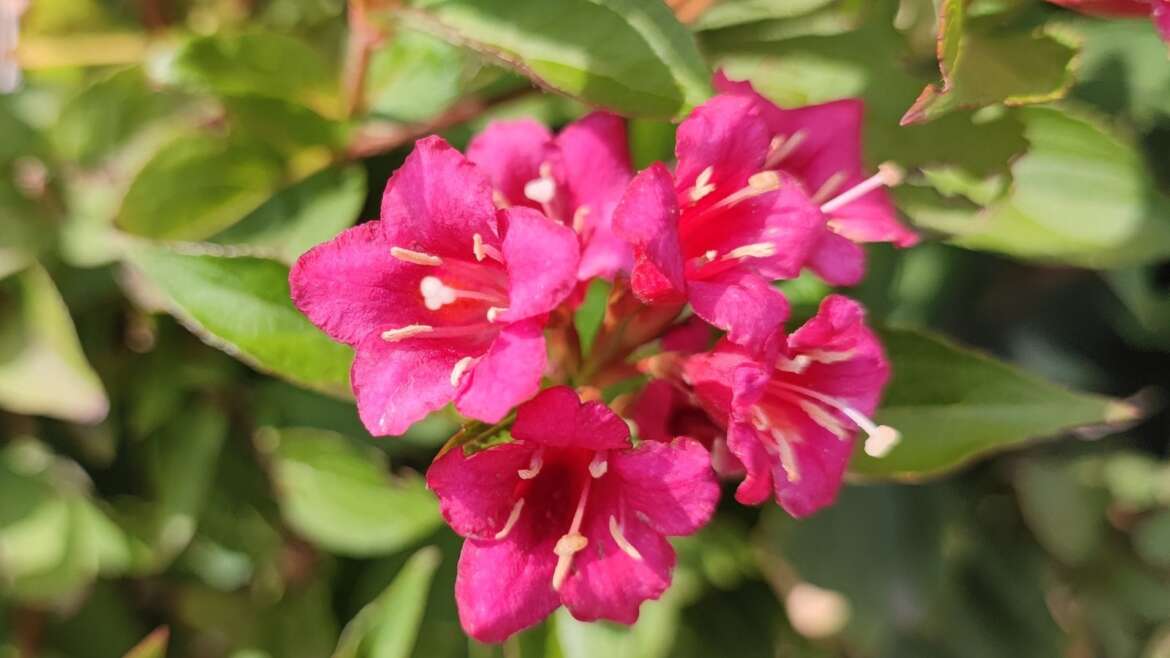Weigela is a gorgeous, flowering, deciduous shrub that grows well in most hardiness zones. It is popular for its low maintenance, stunning colors, and adaptability.
They attract hummingbirds, butterflies, and other beloved pollinators, but not deer, making it a perfect choice for urban and rural growers. With loads of color and height options, there is a weigela for all garden styles and sizes.
Let’s dive into some of my favorite weigela varieties that I bet you’ll love.
‘Sonic Bloom Wine™’
The plant’s striking deep green and purple foliage enhance gardens.
‘Sonic Bloom Wine’ was added to the Proven Winners® Direct lineup in 2024, making it one of the newest members. Enjoy its bubblegum pink, bell-shaped flowers that rebloom all season.
Its medium size and gorgeous deep green and purple foliage complement most gardens. Plant it with annual whites and dark flowers for a nice contrast.
Give it three to four feet to spread out, and get ready for the pollinators to flock to it!
‘Very Fine Wine®’
 This deer-resistant shrub thrives in moist, well-draining soil.
This deer-resistant shrub thrives in moist, well-draining soil.
This improved ‘Fine Wine’ blooms spring through fall and offers deep autumnal shades. This cultivar was bred for darker purple foliage and showcases even more gorgeous rose-colored flowers. Hummingbirds and butterflies love the tubular-shaped flowers.
Plant this shrub in moist, well-draining soil of various types, including clay. Plant ‘Very Fine Wine®’ along borders or in mass to make a statement. This weigela remains fairly compact, perfect for patios and small gardens.
The shrubs are sturdy and hardy down to zone 4 and deer-resistant.
‘Crimson Kisses®’
 Plant near windows or borders to enjoy their sweet fragrance.
Plant near windows or borders to enjoy their sweet fragrance.
This absolute stunner looks as sweet as candy with abundant upright bright red-lipped flowers, bright white stamen, and luscious foliage of medium to dark green.
‘Crimson Kisses®’ shrubs have a moderate growth rate and remain vigorous all season, attracting pollinators.
Plant these beauties near your home or a frequently opened window to enjoy their sweet fragrance, or place them along a border.
‘Wine and Roses®’
 This shrub is recognized for its hardiness and resistance to pests and diseases.
This shrub is recognized for its hardiness and resistance to pests and diseases.
This stunning deep maroon option blooms bright pink flowers once in mid to late spring and again in the fall, depending on the growing zone. ‘Wine and Roses®’ came from breeding several varieties to create dark foliage.
It has amazing hardiness and isn’t bothered by many pests or diseases. It is a Proven Winners® Colorchoice® flowering shrub and has been recognized by Penn State as Gardener Selects.
Add one of these shrubs as a statement piece, along your driveway, or as a lovely privacy hedgerow.
‘Lemon Ice’
 The ‘Lemon Ice’ needs five to six feet to spread out
The ‘Lemon Ice’ needs five to six feet to spread out
This modern spin on weigela blooms earlier than most but later than forsythia, which is the first in bloom across many growing zones. This cultivar boasts pale yellow flowers on bright chartreuse foliage, offering a unique spring color before your bright annuals. Immature branches are a dark reddish shade.
The foliage sticks around all summer and the flowers will rebloom again in the fall. It’s easy to design alongside deep-colored shrubs or bright flowers to make them stand out.
Give this guy five to six feet to spread out. Growth habit is slightly arching. No deadheading is necessary.
‘Vinho Verde’
 This is an upright plant that adds a refreshing touch to gardens.
This is an upright plant that adds a refreshing touch to gardens.
‘Briant’s Rubidor’ and ‘Naomi Campbell’ had a baby! This unique cultivar combined golden and burgundy varieties, with the outcome being this incredibly unique option with green and black variegated foliage. While some pink flowers bloom in late spring, the foliage is the star.
Named for a refreshing Portuguese wine, ‘Vinho Verde’ will add a crisp look to your garden. Its growth habit is tidy and upright.
Grow ‘Vinho Verde’ in containers, in mass, or along a border. A proven winner.
‘Electric Love’
 Provide ‘Electric Love’ with afternoon shade during hot weather.
Provide ‘Electric Love’ with afternoon shade during hot weather.
‘Electric Love’ adds great contrast to the lush greens of spring with its deep bronze foliage and bright red flowers. Its compact nature makes it easy to grow in containers, add to a low border, or incorporate into other landscaping shrubs.
Weigela will appreciate some afternoon shade when the temperatures and sun are harsh. This cultivar has some drought tolerance but should be watered consistently when newly transplanted and during year one.
Mulching will help a strong root system develop and hold in moisture, but don’t allow the soil to become soggy.
‘Tuxedo™’ / ‘Date Night™ Tuxedo™’
 Transplant this by doubling pot size for root alignment.
Transplant this by doubling pot size for root alignment.
This classy, romantic weigela features purple leaves so dark they appear black. The tubular flowers are white with soft peach accents. Place it somewhere you can view it every day and enjoy its beauty.
A moderate growth rate will translate to a foot or two of new height per year. Give each shrub two to three feet of space to spread out.
When transplanting a new weigela, make a hole double the size of the pot it came in to allow the root ball top to line up with the soil surface. Tamp it down and water it in. Voila!
‘Czechmark Trilogy® ’
 A weigela variety called ‘Czechmark Trilogy’ is suitable for decorative landscaping.
A weigela variety called ‘Czechmark Trilogy’ is suitable for decorative landscaping.
It doesn’t get better than this. Low maintenance, multiple color blooms, compact, long bloom time, little to no pest and disease pressure, and compact enough to grow in containers. Starting white, ‘Czechmark Trilogy®’ flowers transition to pink and later red into the summer.
Blooms are 1 ½ inches long, much larger, and longer than other weigela varieties. Clusters include up to 20 flowers compared to the four or five most other varieties offer.
Shrubs tolerate some soil dryness once established but ensure soil is well-draining and do a light prune after the spring bloom. Make a statement with driveway edging, planters on your patio, or in mass.
‘Sonic Bloom Red’
 Encourage healthy growth with spring application of fertilizer and mulch for weed control.
Encourage healthy growth with spring application of fertilizer and mulch for weed control.
Breeders of ‘Sonic Bloom Red®’ broke the “bloom barrier”, creating this cultivar that starts in the early summer, with a heavy flush of bright reddish pink flowers in May and June, reblooming through fall!
Flower clusters are prolific and dense and the shrub has an arching, bushy habit with a fast growth rate.
Apply a well-balanced, slow-release fertilizer and aged manure in the spring before new growth emerges to encourage new growth and healthy foliage. Optional mulching will keep weed pressure down and help retain moisture.
‘Variegated’
 Underplanting this plant with colorful perennials enhances its beauty.
Underplanting this plant with colorful perennials enhances its beauty.
This is an easy to care for, garden staple. If you’re just starting, place a ‘Variegated’ weigela in the center and work around it. Its arrow-shaped, light green leaves have unique creamy edges and bloom pink flowers from spring to early summer. The variegation will add interest and remain fully contrasted with at least six to eight hours of sun daily.
If you keep bees, weigela is the perfect food source for your hive, providing lots of nectar.
Companion plants for underplanting weigela shrubs include colorful perennials like peonies, coneflowers, and columbine. Variegated weigela should be given six feet on all sides to spread out.
‘Pink Poppet’
 The ‘Pink Poppet’ weigela is hardy to zone 3.
The ‘Pink Poppet’ weigela is hardy to zone 3.
With the cutest name and softest pink flowers, ‘Pink Poppet’ will delight garden visitors. Blooming amongst its medium-green foliage in the spring, it reblooms in the summer.
Northern growers take note, ‘Pink Poppet’ is hardy down to zone 3! Remaining small, it’s the perfect weigela for containers, edging, or planting in mass.
Deep watering is recommended to avoid sitting water on foliage and reduce disease risk.
‘Spilled Wine®’
 This variety performs well in poor soil with annual spring feeding.
This variety performs well in poor soil with annual spring feeding.
This compact Proven Winners Direct member is a low-growing weigela, easy to add along a pathway or in the front of garden plots. Its flowers are a vibrant purple-pink shade with lovely deep burgundy foliage. Mulch will make the colors pop.
Weigela doesn’t mind poor soil conditions but will appreciate an annual spring feed. Lightly prune after the spring bloom, then you can leave it alone, and it will perform well.
Bloom time lasts from May to July in most regions.
‘Midnight Sun™’
 The ‘Midnight Sun’ requires low water but should be soaked if the base feels dry.
The ‘Midnight Sun’ requires low water but should be soaked if the base feels dry.
Grown for its unique, multi-colored foliage, ‘Midnight Sun™’ gives tye-dye vibes. While it blooms pink flowers in late spring, the real interest comes in fall when foliage delights with green, yellow, pink, and purple shades.
Use this low-growing cultivar as a filler in containers. pH can be well-balanced or slightly acidic.
Weigela has low water needs but should be watered during extreme drought. If the base of the plant feels dry, give it a good soaking.
‘My Monet® Purple Effect’
 These shrubs maintain tidy shapes with minimal pruning.
These shrubs maintain tidy shapes with minimal pruning.
A dwarf variegated stunner, ‘My Monet® Purple Effect’ has slender, minty green and white leaves and deep purplish-pink flowers that bloom in late spring. Stems are erect and spiky.
This Proven Winners Direct member stays fairly low to the ground and will make friends with most perennials. The light foliage adds a lovely, clean contrast when paired with bright shades.
Shrubs remain tidy and nicely shaped naturally without much need for pruning.
‘Minuet’
 A versatile plant known as ‘Minuet’ weigela thrives in containers.
A versatile plant known as ‘Minuet’ weigela thrives in containers.
This reliable beauty is a dwarf weigela variety that boasts trumpet-like bright reddish-pink blooms with yellow throats. The blooming season is spring and summer, zone dependent and growth is dense.
Perfect for container growers but also do well grown alongside perennials, used as a foundation or a short hedgerow. ‘Minuet’ will perform well in normal and sandy soils.
Weigela flowers work well in crafting, including glycerinizing. If you love crafting, try it out!
‘Red Prince’
 Provide this with ample space of five to seven feet on each side.
Provide this with ample space of five to seven feet on each side.
This giant, hardy variety has showy red flowers with an open structure and medium green foliage. Growers love it for its dramatic height, non-fading color, and extreme hardiness down to -13°F (-25°C).
You’re likely to get a second flush of blooms in late summer. Pollinators love weigela but deer pay it no mind, so position it wherever you’d like in your garden.
Give this lady some room to spread out! Five to seven feet on either side will allow her to branch out properly.
Final Thoughts
If you haven’t already added weigela shrubs to your landscaping plans, I bet you’re adding them to your list now. They’re easy to care, have low pest and disease threats, and offer big rewards. Some are known for their gorgeous foliage, and others show off with bright flowers. Whichever you choose, they’ll perform well in well-draining soil with just a light prune each season. Weigela doesn’t disappoint!




